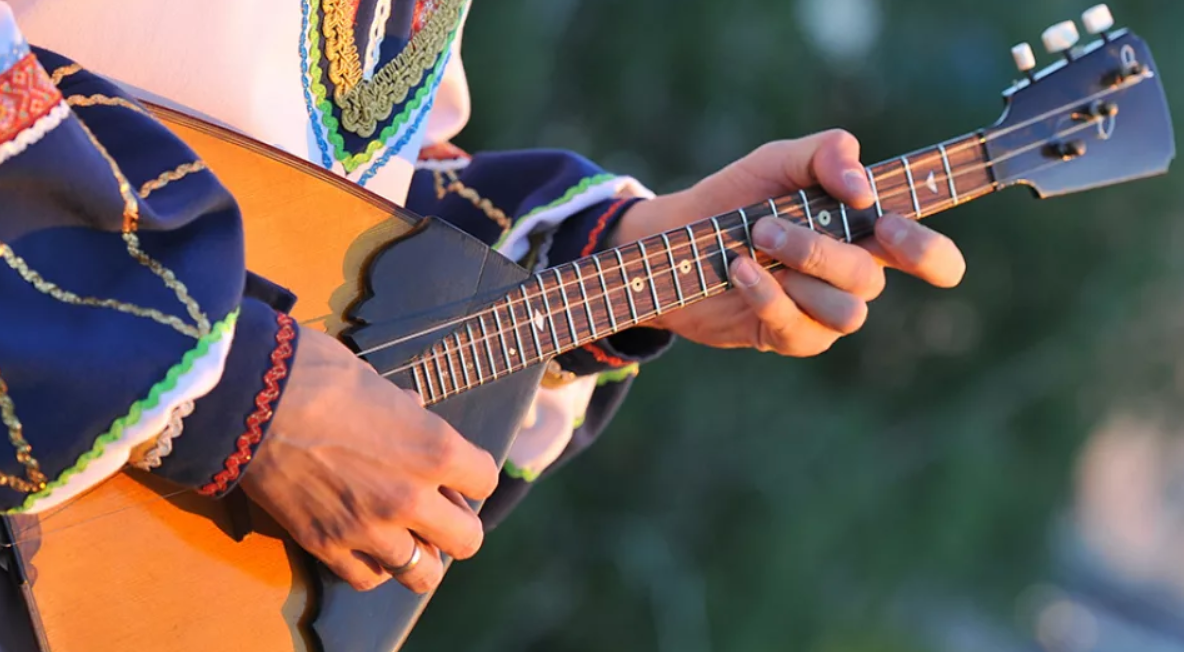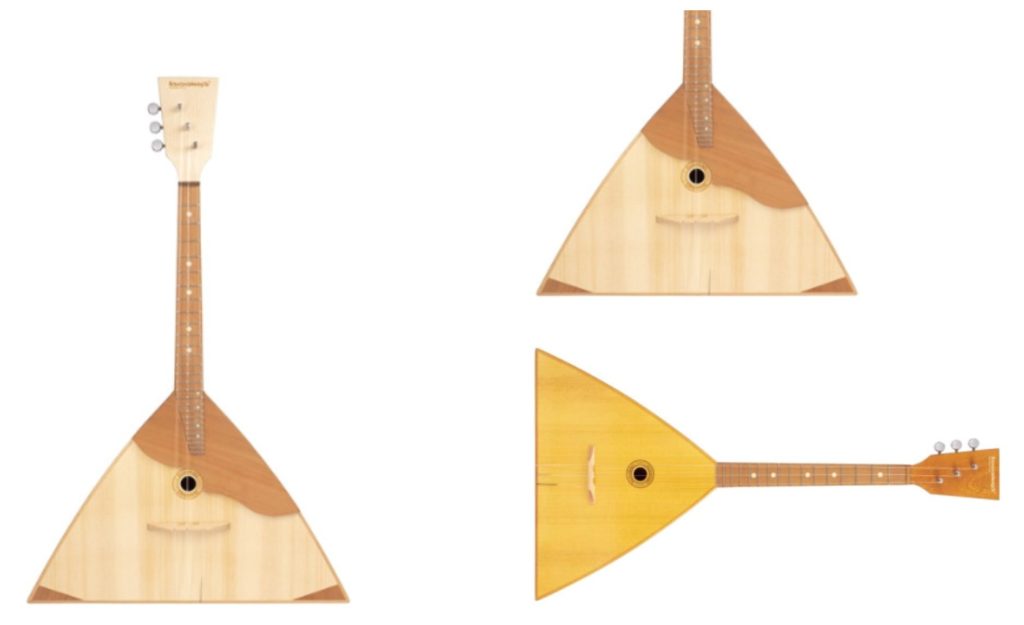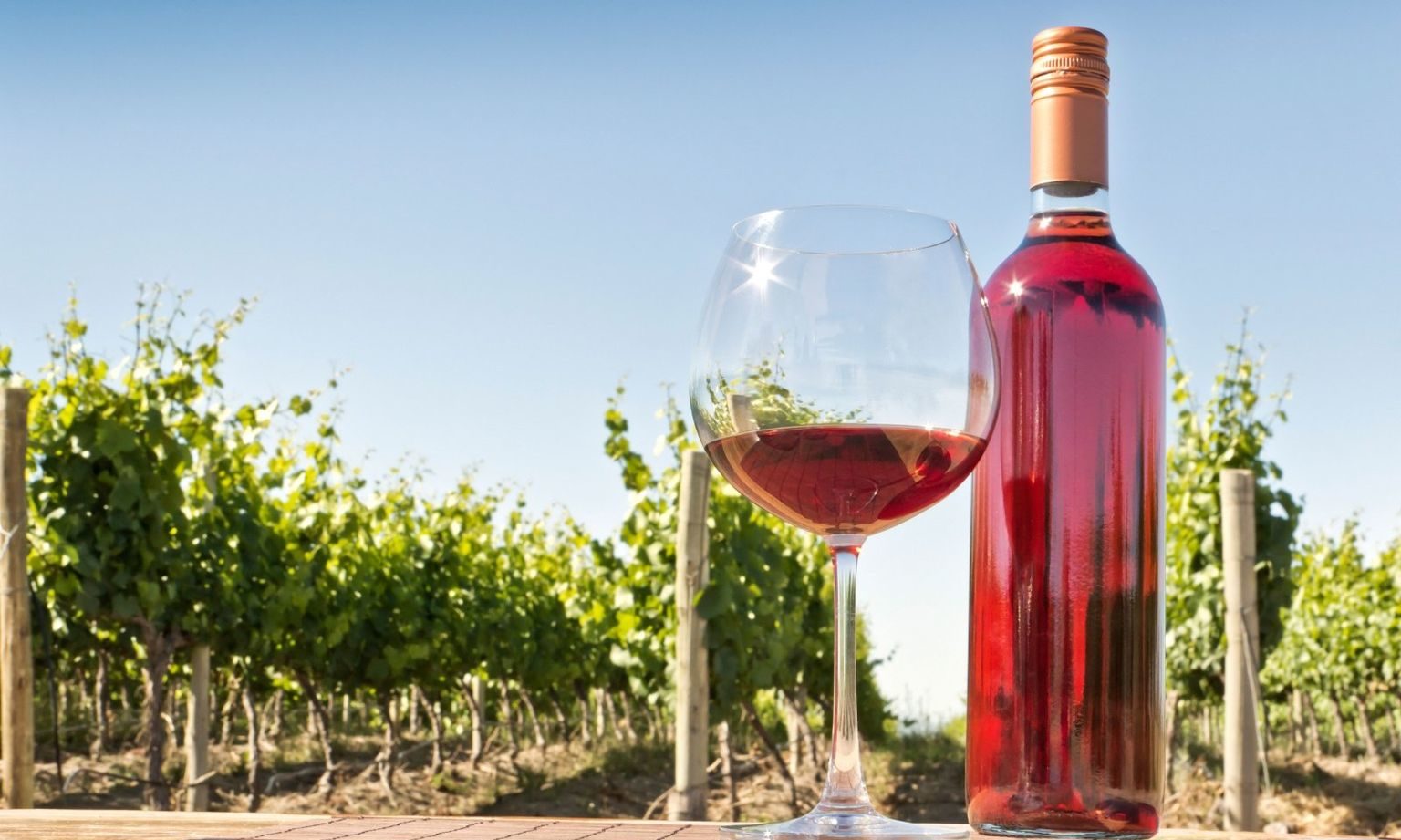Best balalaikas for 2024

With the emergence of interest in the national culture, and also thanks to the efforts of enthusiastic collectors of folklore, we learned about the Russian balalaika - a widespread musical instrument. The Russian soul, with heartfelt anguish and daring revelry, has always needed musical accompaniment.
Today the plucked instrument is used by performers of music of various styles and genres - from classical to rock and jazz. This is a symbol of the Russian people. Therefore, the question often arises of how to choose a balalaika.
Recently, interest in the balalaika as a phenomenon of Russian culture has grown greatly. When choosing music courses, more and more people prefer this folk instrument. And the concerts of balalaika virtuosos are sold out even abroad.
Origin story
The word has the root bal-, the same as in the verbs balabolit, balakat - to chat, to ring off. Supporters of the theory of oriental origin argue that balalaika comes from the Turkic word "bala" - child.
However, most researchers are of the opinion that it appeared during the times of Muscovite Russia, as a replacement for the disappeared buffoon domra.
It is often mentioned in written, visual and oral folklore sources. Cheerful, light sounds convey life in Russia, they helped our ancestors to forget about the severity of peasant life.
It quickly spread due to its lightness, low cost of manufacture. Craftsmen began to make their own versions - from rare specimens with a long neck, oval body to popular ones with a characteristic triangular body. In appearance, the balalaika was very different from the one with which Russian culture is today associated.
Only by the end of the 19th century, Vasily Andreev reworked the balalaika - updated it for later professional use as a stage instrument. It is this option that has survived to this day.
How to choose a tool
First you need to choose a model. It is better to buy a high-quality one right away to make it easier to learn to play. Do not forget that only a good quality musical product can give a melodious sound.
Balalaika device
The main source of sound is strings. Various methods of sound production are used, for example, rattling, tremolo - alternating strokes with the index finger of the right (left) hand down and up, using the forearm and hand. That is, the performer needs to hit the stretched flexible strings to get the sound.
The greater the vibration amplitude, the stronger the sound.The force of sound production depends on the length, diameter, tension of the strings, as well as on the material of manufacture of the components.
Main parts
- Body (body) consisting of a triangular deck and neck. Length - 60-70 cm. Width of the lower part - 40 cm, upper - 5 cm. It is made of pine wood using 5-10 staves. Therefore, they are called five-, six-rivet.
- Deck glued from individual wooden segments. There is a flower-shaped resonator on it. Above the resonator there is a shell that protects against blows. Not all options are equipped with a shell, for example, on the children's ones instead of a flower or a berry.
- Vulture. Preferably without distortions, cracks.
- Frets, quantity 16-31.
- The upper part is the shoulder blade. Here is the setting device. A worm gear is used for precise fixation.
- Strings. There are carbon, nylon, metal. For the harmonious beauty of the performance, they should not be too thick, so as not to deprive the instrument of melodiousness. The subtle ones also affect the sound quality - they give a rattling, weak sound.

A good piece of music is characterized by a strong sound and pleasant timbre. Such sound production gives only an instrument made by the hand of a master with a mathematically correct tone of the resonance box. While playing on it, even a novice balalaika player will be able to practice with intonation variations.
Criterias of choice
When choosing, you should pay attention to some design features:
- appearance - body without defects;
- straight neck is required;
- neatly polished fret plates;
- pegs - metal;
- when playing, the tuning mechanism does not rattle;
- the grooves on the stand are located at the correct distance so that the strings do not touch, for example, during a double pizzicato.
Quality also depends on the right strings. With thin ones the sound will be rattling, with thick ones the melodiousness disappears.
A quality piece of music has a long, pleasant sound when plucked. The tool is comfortable to hold and has a beautiful appearance. It is also necessary to check the system. And the most important thing is to like the balalaika.
Council. When choosing a musical product, it is better to invite a specialist.
Varieties of balalaikas
Dombra contributed to the appearance. Therefore, initially the instrument had a completely different look - it had only 2 strings.
Improvement work began in the 19th century for a better sound. Much depends on the sound setting. There are also design differences.
According to the method of sound production, it is divided into several types:
- Balalaika Prima. Solo instrument. The timbre is clear. Academic system - Mi, Mi, A of the first octave.
- Balalaika Second. Performs accompaniment functions. Sounds one fifth lower. Slightly muted tone. Tuning - La, La, Re (La of the small octave, Re of the first octave).
- Balalaika Alt. Moves down one octave. The range is up to the second octave. Realizes harmonious filling of the instrument. Soft and juicy timbre. Stroy - Mi, Mi, La of a small octave.
- Balalaika Bass. Refers to the bass group. The timbre is low. Plays in a large octave. Stroy - Mi, La, Re of a large octave.
- Balalaika Double bass. A big, powerful tool. Performs bass function. Stroy - Mi, La, Re of counter octaves. It differs from Bass in that it plays in a counter octave.
- Balalaika Piccolo. The smallest. Emphasizes the upper case of the work. Stroy - Mi, Mi, A of the second octave.
Prima is the leading instrument, others are orchestral auxiliary functions.
Among ordinary people, performing under a certain balalaika type is common. Products with nylon strings, an extended scale, and an academic system are in demand among professionals.
By purpose, it is divided into two types:
- Professional (academic). Requires musical education.
- Folk (traditional, village). Differs in the number of frets. Musical theory is not required to master.
The demand for traditional music products has grown over the past few years.With their help, information is transmitted about how our distant ancestors knew how to harmonize with nature.
Balalaikas rating for 2024
In order to facilitate the selection of a suitable product, we have prepared a rating of popular balalaikas for beginners.
Please note that such products should not be cheap. As a rule, cheap ones are made of poorly dried wood, which is why they are subject to temperature effects.
Forest F-203
Orchestral second for the performance of pieces of music. Fully reveals the sound of other professional instruments.
A large number of musicians, when they talk about the sound of an old village balalaika, mean exactly the second.

main parameters
| Scale | 475-490 mm |
| Vulture | beech |
| Carapace | ABS plastic (plastic) |
| Top deck | solid resonant spruce |
| Housing | beech |
| Tuning Mechanics | metal, on one bar |
Scale (measure) - the maximum segment (length) of a string that is able to sound (oscillate).
- smooth neck;
- hard, polished frets;
- smooth rotation of the tuning machine;
- loud sound, excellent sounding of notes;
- quality tuners.
- the varnish on the fretboard is quickly erased, chipped;
- the shield is too close to the strings;
- the material of the flap is rough; when clinging to it with a finger, it gives a bad sound.
The design features of the Forest F-203 resonance deck, as well as the accumulated experience of the craftsmen and the latest development technologies have contributed to the original sound of the instrument in terms of strength and timbre.
Simplicity, which is combined with a special way of sound extraction, allows you to create unusual sounds unfamiliar to world music practice.
Doff F-201
A three-string musical product of plucked type. An instrument with hand-painted artistic painting on a folklore theme creates a unique sound, which is the basis of Russian folk melody.
Ideal for gifts, souvenirs.

main parameters
| Scale | 435-450 mm |
| Vulture | beech |
| Top deck | plywood |
| Housing | beech |
| Weight | 1.35 kg |
| Finishing | hand-painted |
- unique appearance;
- smooth rotation of the tuning machine;
- ease, accuracy of settings;
- hand-painted.
- deck material plywood;
- sounding dull due to the large distance between the strings and the neck;
- unpolished frets cut fingers.
The balalaika has become a symbol of Russia for foreigners, so the Doff F201 painted product is often used as a souvenir with ethnic content.
This instrument can be used to perform folk compositions. And also the piece of music will serve as a stylish accessory that decorates the interior.
BPD Wooden balalaika prima, Izhevsk plant T.I.M
It was created at the Izhevsk plant especially for beginners. Izhevsk plant T.I.M.
produces more than 30 types of balalaikas, dombras, as well as components for assembly.

main parameters
| Scale | 440 mm |
| Vulture | pasted |
| Soundboard | resonance - spruce, plywood - birch |
| Weight | 1.5KG |
| Housing | plastic (300x450 mm) |
- the deck sounds good at the top;
- durable varnish;
- the shield is far from the strings;
- body, soundboard give volume;
- price.
- the quality of the peg mechanism;
- frets made of soft metal;
- the saddle (near the strings) rebounds quickly.
Lovers of folk music products will appreciate the quality of birch workmanship. Good for beginners. Balanced sound. Suitable for classes with or without a teacher.
Tip: If you replace the tuning mechanism, the balalaika will delight you much longer, since you will not often have to be distracted by tuning.
Balalaiker HS-K
Russian-made product. It has three strings, a triangular body, belongs to the group of stringed plucked instruments.
The manufactory is located in the city of Ulyanovsk. Since 2013 it has been producing balalaikas, wheeled lyres, musical accessories.The craftsmen restored the technology of assembling the balalaika body thanks to the ethnographic samples of the mid-19th century. The voice of ancient peasant Russia was preserved.

main parameters
| Scale | 435 mm |
| Length | 630 mm |
| Vulture | Pine |
| Soundboard | spruce |
| Housing | Pine |
- build quality;
- original color combination;
- slim neck - the best instrument in this price range;
- keeps the line;
- the shell goes far - it's easy to play an ordinary pizzicato;
- excellent value for money;
- high-quality mechanics;
- neat shell.
- inexpressive, flat sound due to the thickness of the deck;
- the stand rides, it is recommended to add rosin under it;
- frets protrude above the shell;
- the neck is varnished and needs to be sanded.
Great for the beginner balalaika player. The neck is comfortable - you can completely wrap your thumb around it, the thickness allows.
A common version of the old form. The rave reviews of contemporaries of this unique species attract many.
The original sound will surely bring a lot of positive emotions to connoisseurs of early music.
Balalaiker BSS AE Student
Academic electroacoustic balalaika. It is characterized by a classic size, proven materials, convenience, mobility, as well as stability of sound production without additional wires and devices.
A great learning tool thanks to the well-proven ergonomics of the parts and neat assembly. The stability of the sound signal is provided by the built-in electronic amplifier. The sound of the instrument is light.

main parameters
| Scale | 435 mm |
| Vulture | maple |
| Top deck | resonant spruce |
| Housing | beech |
| Stand | pear |
| Pickup | piezo ceramic, Cherub |
| Nutrition | battery cell CR2032 |
| Output | TRS 1/4 (6.35mm) |
- recognizable design;
- all-bar tuner system;
- metal strings;
- scale of 27 frets;
- made from natural materials;
- tinted finish.
- the neck is not perfectly smooth;
- difficult to control the tuners.
Balalaiker works great on sound across the entire spectrum, making learning a joy.
Balalaiker Color Engineering's unique knitting technology, as well as modern decoration, have allowed the craftsmen to achieve a rare combination of modern design, historical style and unforgettable sound production.
Balalaiker 3S-BF Black Fedor
A noticeable and recognizable tool due to the color scheme - the finish is made in black.
The model also features a compact flat-bottomed body.
Yesterday it was made only in homemade versions. Today Cherny Fedor is in demand among amateur musicians and stage performers.

main parameters
| Scale | 435 mm, 16 frets |
| total length | 652 mm |
| Top deck | resonant spruce |
| Vulture | birch, oval |
| Stand | maple |
| Finishing | black tinted |
- unique appearance;
- compact body shape;
- tinted black finish;
- open-type peg system.
- for fine adjustment, you need to move the stand;
- use under the light of powerful lamps is not allowed.
The instrument can be tuned for songs, dances, quiet playing music, etc. Convenient for travel, outdoor activities, and also perfect for lessons with children.
Balalaiker Peasant HS-K
A historical instrument made of solid spruce. Until the end of the XIX century. was the most popular option in Russia. It sounded in taverns, at fairs or just on the street, among workers and peasants.
Balalaiker studied the original historical specimens of this species. They managed to restore the body assembly technology of that era.

main parameters
| Scale | 415 mm, 5 frets |
| total length | 580 mm |
| Top deck | resonant spruce |
| Vulture | spruce |
| Housing | spruce, five-rivet historical |
| Tuning Mechanics | single friction type |
- historical appearance;
- material of manufacture.
- the sound is dull, the timbre is sandy and diffuse;
- hard to tune - strings stretch, stretch for a long time.
It is easy to learn the simplest play on such a balalaika. The peasant woman is used in folk music practice, in the family circle, and it is also an instrument for independent amateur playing music.
The old-fashioned balalaika will bring many vivid emotions to anyone due to the tangible flow of archaic Russian sound.
Children's room with bells. Workshop Serebrov K2-BL-01
Made of 8 mm plywood. Decorated with Gorodets painting. There are three bells in the neck area; strings are not provided. It is a noise instrument of the 2nd category, that is, it is designed for folklore and choreographic lessons in preschool institutions.
Sings with character and mood.

main parameters
| Material | wood, metal |
| Dimensions (LxWxH) | 47.3x31.5x0.5 cm |
| Weight | 1170 g |
The strings and frets are drawn. The sound is provided by three bells.
This balalaika can be used when organizing performances in kindergarten or elementary school to support Russian folk art.
How to quickly and accurately tune the instrument
The sound of Russian folk instruments, especially strings, is subconsciously associated with patriotism among our fellow citizens. Only a properly tuned piece of music can convey these feelings.
There are many ways to customize. The most common is folk. Professional musicians use the quart tuning - academic.
People's system
It is also called major or amateur:
- the first A string;
- the second is Mi;
- third - Before.
This tuning makes it easier to play a triad, but harder to play with open strings.
Academic structure
- two strings in unison - Mi note;
- one - a fourth higher - the note A.
For tuning, an accordion, piano, guitar, tuner, etc. are used.
Tuning with a tuner
- First you need to fix the device on the balalaika neck. The device can read the vibrations of the strings using the built-in piezo pickup, or with a cable directly connected to the guitar.
- Then start setting up. The instrument shows the note of the sound of the string in Latin letters: A is indicated by the letter A, Mi - by the letter E.
Used for final finishing of the string. Such a device will help you adjust the balalaika yourself.
Setting up with Android
- The first step is to download Pitched - Tuner to your phone or tablet. The program perceives the sound of the guitar, determines the current pitch. Convenient interface. Easy navigation.
- Then tune the bottom string to A 4, and the top two to Mi 4.
Such programs are widespread on the network, but their main drawback is poor tuning accuracy in a noisy room. A clean chord is heard after tuning.
There is no perfect way to set it up. It is important to focus on the whole range of possibilities that allow the chosen tool to be as versatile as possible. The decision is easier to make with performance skills.
Reasons why it is impossible to tune the instrument:
- the neck is deformed;
- strings are of poor quality, poorly fixed;
- the size of the stand does not fit the surface of the deck;
- inaccurate fret markings.
Council. Tighten the strings carefully before tuning.
Recommendations
- The strings require constant maintenance. The brightness of the sound depends on them. Over time, they are deformed - stretched, oxidized, the calibration is broken.
- The fretboard on which the frets are located is smooth, without cracks, comfortable to grip.
- The frets are sanded with a sandpaper. They are the same height.
- The carapace does not touch the soundboard.
- An improperly selected stand height can impair sound production.
- A good piece of music is made from natural materials, polished, and meets standard quality requirements.
- It is not recommended to store in the sun, near heating or in a place that is too dry - the body and deck will burst.
- To protect it better, use tarpaulin covers or special storage cases.
conclusions
Earlier balalaikas ensured the survival of the Russian peasant. Today, the revival of traditions is a spiritual and moral renewal of society.
To preserve folk customs, rituals, games, it has a special role. After all, it was she who captured fragments of the life of the Russian people, contributed to the awakening, the development of interest in the cultural traditions of our country.
Due to the affordability of a domestic manufacturer, anyone can buy a Russian balalaika.
new entries
Categories
Useful
Popular articles
-

Top rating of the best and inexpensive scooters up to 50 cubic meters in 2024
Views: 97661 -

Rating of the best materials for noise insulation for an apartment in 2024
Views: 95022 -

Rating of cheap analogues of expensive medicines for flu and colds for 2024
Views: 91750 -

The best men's running shoes in 2024
Views: 87680 -

Top ranking of the best smartwatches 2024 - price-quality
Views: 85091 -

Best Complex Vitamins in 2024
Views: 84801 -

The best dye for gray hair - 2024 top ranking
Views: 82406 -

Rating of the best wood paints for interior use in 2024
Views: 77202 -

Ranking of the best action cameras from China in 2024
Views: 75269 -

Rating of the best spinning reels in 2024
Views: 74827 -

The most effective calcium supplements for adults and children in 2024
Views: 72462 -

Top rating of the best means for male potency in 2024 with a description
Views: 68296









